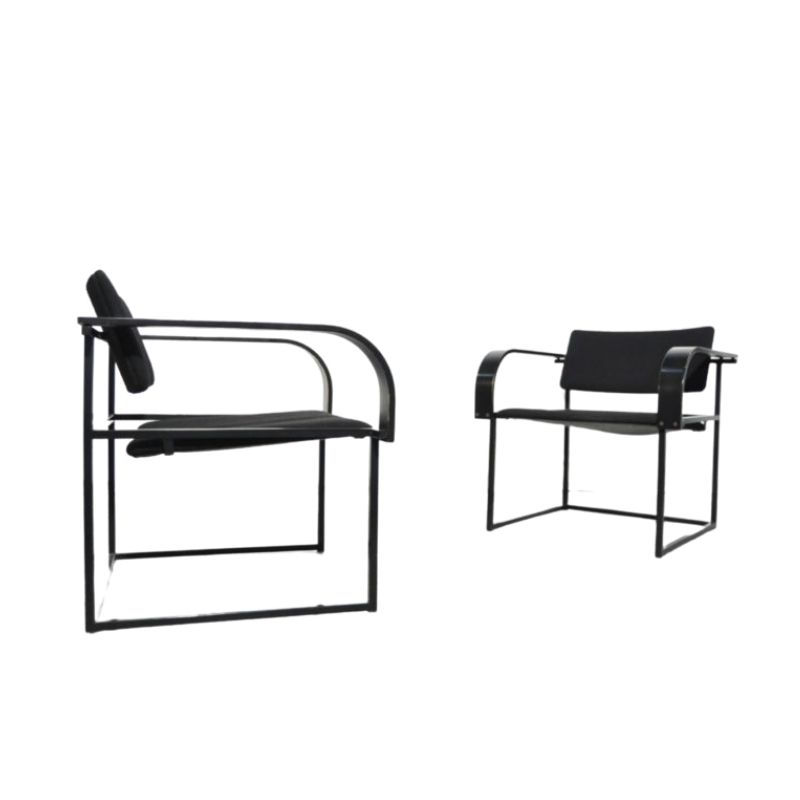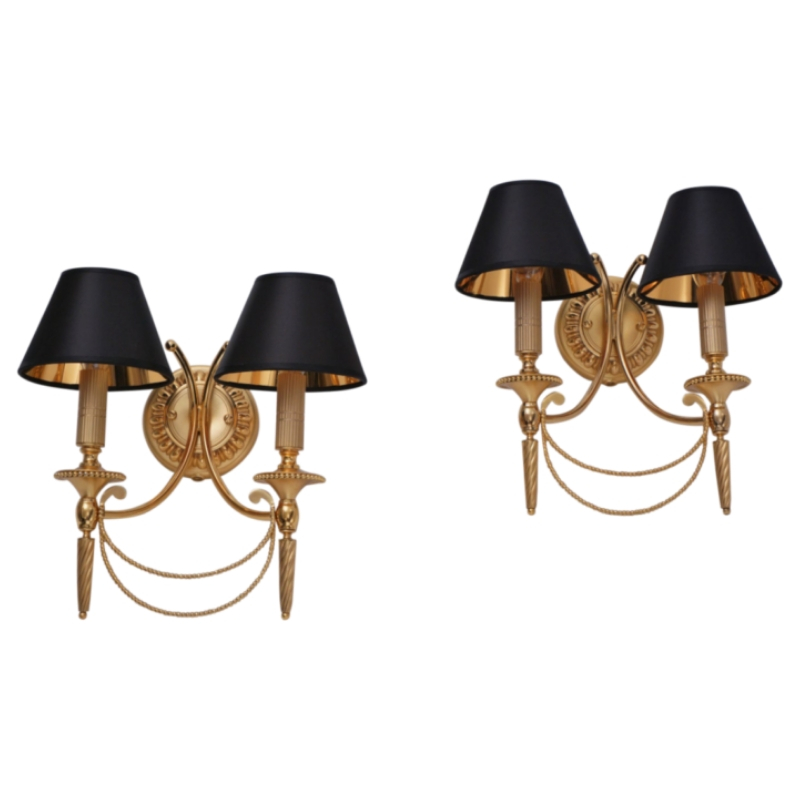I have been thinking about ordering a kit for re-cording my Moller dining chairs from this website: http://www.chairseatweaving.com/danishcordkit.htm . However, since Danish side chairs typically could be purchased with either corded seats or leather/vinyl seats, I was curious if it is a fairly straightforward procedure to convert a corded seat to one made of leather or vinyl? Or are Moller chairs with leather/vinyl seats physically different from those manufactured with corded seats, to the point that replacing cord with leather/vinyl would be rather difficult?
I think... but not sure, unless we pull up some photos, it's a different animal. Built differently for each seat. I need to redo my Wegner seats and am researching all the variations i have seen. In these two quick photos i found, it looks like the construction accommodates both seat finishes.
Although
I am not familiar with these particular chairs, I would be very surprised to learn of any chair in which the wood parts were identical in both its upholstered and woven-seat versions. This is because the requirements of those parts (the front, side and rear seat rails, typically) are so different. For instance, the upholstered seat panel doesn't require all the holes (or occasionally, horizontal dowel members) that are needed to string the seat fibers.
Whether the rails could be modified would depend on the particulars -- but it wouldn't be an original, after such modification, at the very least.
Rockland's
detail photo is quite astounding to me -- and may give the lie to my statement. This chair might have been built to accept both seating materials without modification. I am amazed here by the attachment of jute (?) by staples -- because I cannot quite picture the process. Was a pre-woven seat fabric stapled, one strand (loop) at a time ? Or was the seat woven onto the chair, each strand being stapled as it was placed and stretched ?
It is actually a nail with a ...
It is actually a nail with a specialized head, and not a staple. The seat is made from cord made of twisted paper, woven in a specific fashion, and is not pre-fab. Weaving a Danish cord seat is a quite a lot of work, or at least that is what I have been told. But, that is probably obvious just from looking at one.
One thing that might complicate re-cording a seat is how far these original nails have been driven in. On my Moller chairs, it looks like it could be difficult to get new cord under these nail heads without pulling the nails out, or having to replace them with new nails. That is the main reason I have been thinking of using black leather or vinyl.
I guess what I am uncertain about with the leather/vinyl Moller seats is what supports the seat/padding itself -- Be it a wood panel, or some kind of canvas webbing, etc., stapled to the stretchers.
I am just guessing, but right now I assume that the Moller chairs in Rockland's photo above have some kind of woven canvas strapping as a seat support, followed by some kind of batting/padding material, followed by a leather or vinyl covering that is stretched over everything and stapled to the stretchers. In that case, both the leather/vinyl chairs and the corded chairs would have identical physical construction, and either seat covering could be used.
In the end, I may need to purchase a single Moller side chair with a vinyl seat so I can dissect it and see how it was done at the factory, since I would want to re-do mine as closely to the way it was originally done as possible.
I was surprised
to see the nail as well. Though i had a vague memory of it in previous research.
I once considered the chair but someone gave me the Wegner set. They have
a channel for staples but that is another post and i have 20 projects ahead
of that one...and just a wee bit of time off.
With so many often listed on e-bay, i would search for more detailed photos.
Someone will eventually show the under construction.
My Wegner has a louan panel that sits in a channel to accommodate its thickness.
(1/4 inch) and one has cracked. (it is not a ladder!)
I have not yet managed to...
I have not yet managed to find a photo of the chair's underside on ebay, but auction # 330318881967 is a set of Model 75 Moller chairs with black seats, and the auction states that the chairs have "BRAND NEW Webbing & NEW Black Naugahyde Upholstery". So, it appears that the Moller seat support is webbing, and not a wood panel.
I am still going to have to find some kind of reference photos (or an actual chair) to see how the webbing, batting, and vinyl covering are applied.
HOLD THE PHONE
I've rewoven many Møller chair seats with Danish paper cord. It's not hard to do. It's something that is taught to mentally disabled people as a trade (though plenty of people with abled minds do it, too).
I get my paper cord from Frank's Cane & Rush (link below). I also have the "Caner's Handbook", which they sell, and which has good, clear instructions for weaving these seats. The cord for one chair costs about $9. They sell the L-nails, too--I think by the dozen or you can get a bag of 100 for $8-9. That's what I did. They do fall out once the cording gets damaged and loosened, so it's a good idea to get a bunch for replacements.
To weave the seat, you do the front-to-back strands first, which involves some wrapping around the front and back rails and mostly just keeping the strands evenly spaced. That's the only really tricky part and it's easy enough to do.
Once that's done, you do the side-to-side weaving, which is just under-over across the seat with a double strand pulled off the coil. When you get to the other side, you simply loop the cord around the L-nail underneath and then bring it up to go back the other way.
The seats look really intricate and complicated but they're not. Believe me. I watch TV while I weave, otherwise I'd go bonkers quickly. It's mindless once you get going.
It can be hard on the hands at the end when there's not much room left to get the double strand through the remaining spaces, so if you have arthritis or are prone to tendonitis, this could be a problem.
Woven seats are more comfortable than vinyl or leather, in my opinion. I have both.
I also happen to have a stripped down chairs of each type at the moment. The rails are the same on each. My cord-seat chair has rungs too, but that has nothing to do with what kind of seat will work on it. The vinyl seats have jute webbing and foam. I've redone both and much prefer to weave than to deal with foam and webbing and fabric/vinyl/leather!
http://www.franksupply.com/rushandsupplies.html#danishcord
non-Møller chairs
I've seen some other Danish chairs with woven cord seats where the cord is stapled in place underneath. I have never rewoven one of these. I don't relish the thought of prying out all those staples and stapling the new cord to the right tension.
The L-nails are very easily loosened a bit to facilitate re-weaving, by the way. I use a slot-head screwdriver to coax them out just enough to get the old cord off and the new cord on, then tap them back in with a small hammer. Once in awhile one will break, but that's why I got the bag of replacements.
yes
I think I've used both the unlaced and laced cord. I just talked to Frank's last week and they said the laced was smoother, which should make it easier to weave.
They sell two diameters of cord. Get the smaller one.
Do get the book! It's worth it. It also explains how to do the woven seats with the extra wraps on the sides, like the Wegner CH23 chair below. I have done one of those and it turned out very well.
A couple of other things:
The front-to-back strands should be a little slack. They'll tighten up as you weave the side-to-side strands.
And make sure when weaving the double strand side-to-side that you don't twist it or miss a weave. It's not that hard to undo mistakes but it does take extra time and it adds wear to the cord.
You might want to do a light spray of acrylic varnish on the seats when they're done. Mask off the frame, obviously. The paper cord isn't at all stainproof. It's just brown paper. I read that diluted shellac can be used but I tried it once on a seat I'd just finished and the cord got horribly blotchy. I had to rip it out and reweave it.
For those who are curious
You can view videos of the process of weaving a Danish cord seat at the link below.
http://www.taunton.com/finewoodworking/SkillsAndTechniques/SkillsAndTech...
good video
Good video! It is for that bench specifically, though. Obviously when weaving a chair seat you can't take the chair apart and wrap the rails the way he did before assembling the bench. But other than that it's pretty much the same. He gives some good tips about getting the tension just right.
Finished my first chair today
I got my order of cord from Frank's Cane and Rush, and replaced the broken and worn out cord on one of my six Moller dining chairs. As Spanky said, it is kind of mindless once you get it all figured out, and is more tedious than it is difficult/complicated. While it hardly took all day to do the chair, I do not think I would care to do more than one, or possibly two in a day. So, it is going to take a while for me to get around to finishing all six. Frank's is a very economical source for the cord. The cost to do a single chair is no more than $10 in materials, if that.
Well done!
Great job. Isn't it satisfying to look at that beautifully woven seat knowing you did it yourself? I bet you'll be done with all of them before you know it. I think my limit per day is about four hours of weaving and that's only if there's something really good on TV. And even then, I can't keep that rate up on a daily basis, at least not for more than a few days. The tendons and ligaments protest.
But still, even with breaks, it goes pretty quickly. I'm glad you took the plunge. I'm all for people trying new things that seem hard but really aren't.
If you need any help, please contact us at – info@designaddict.com









